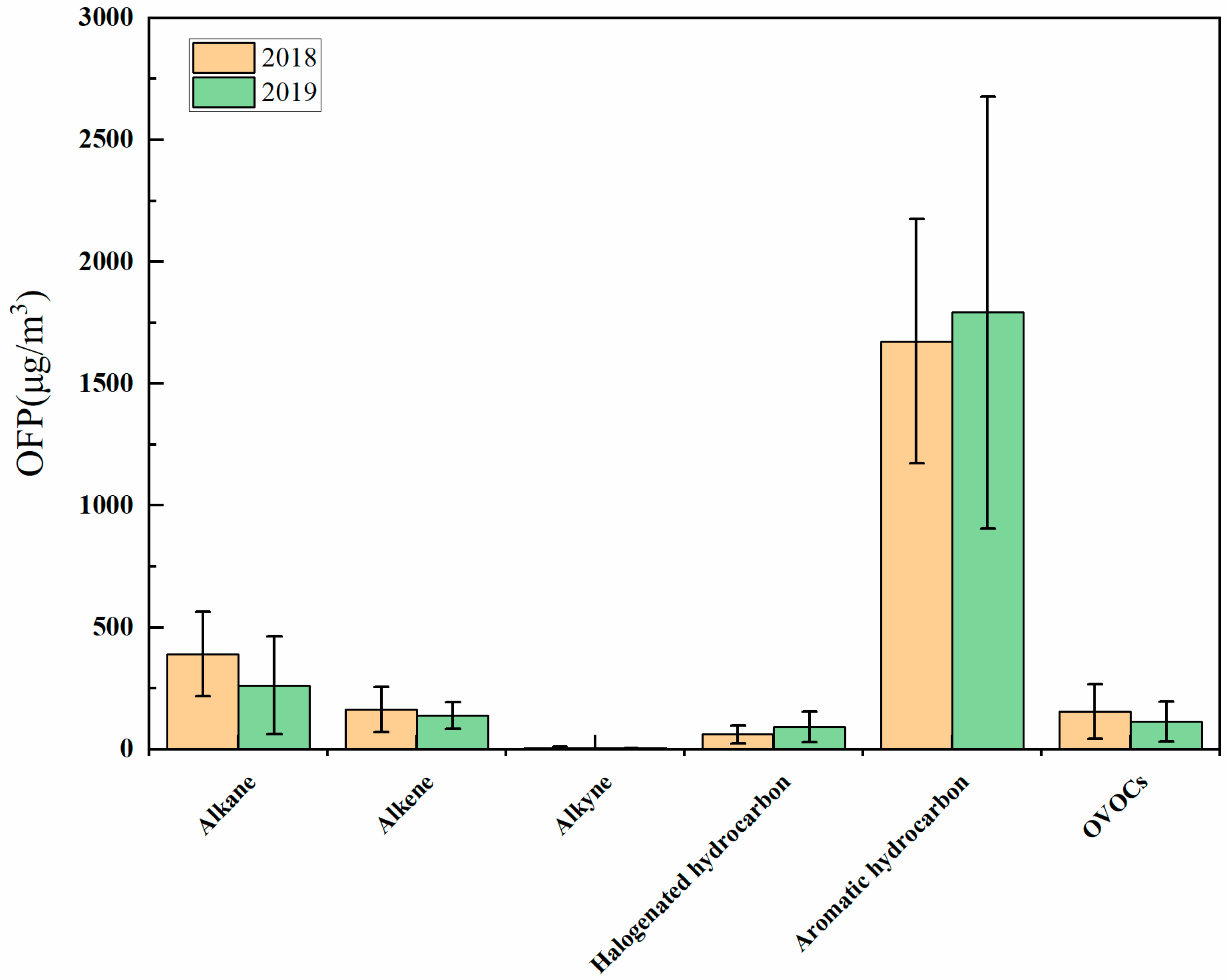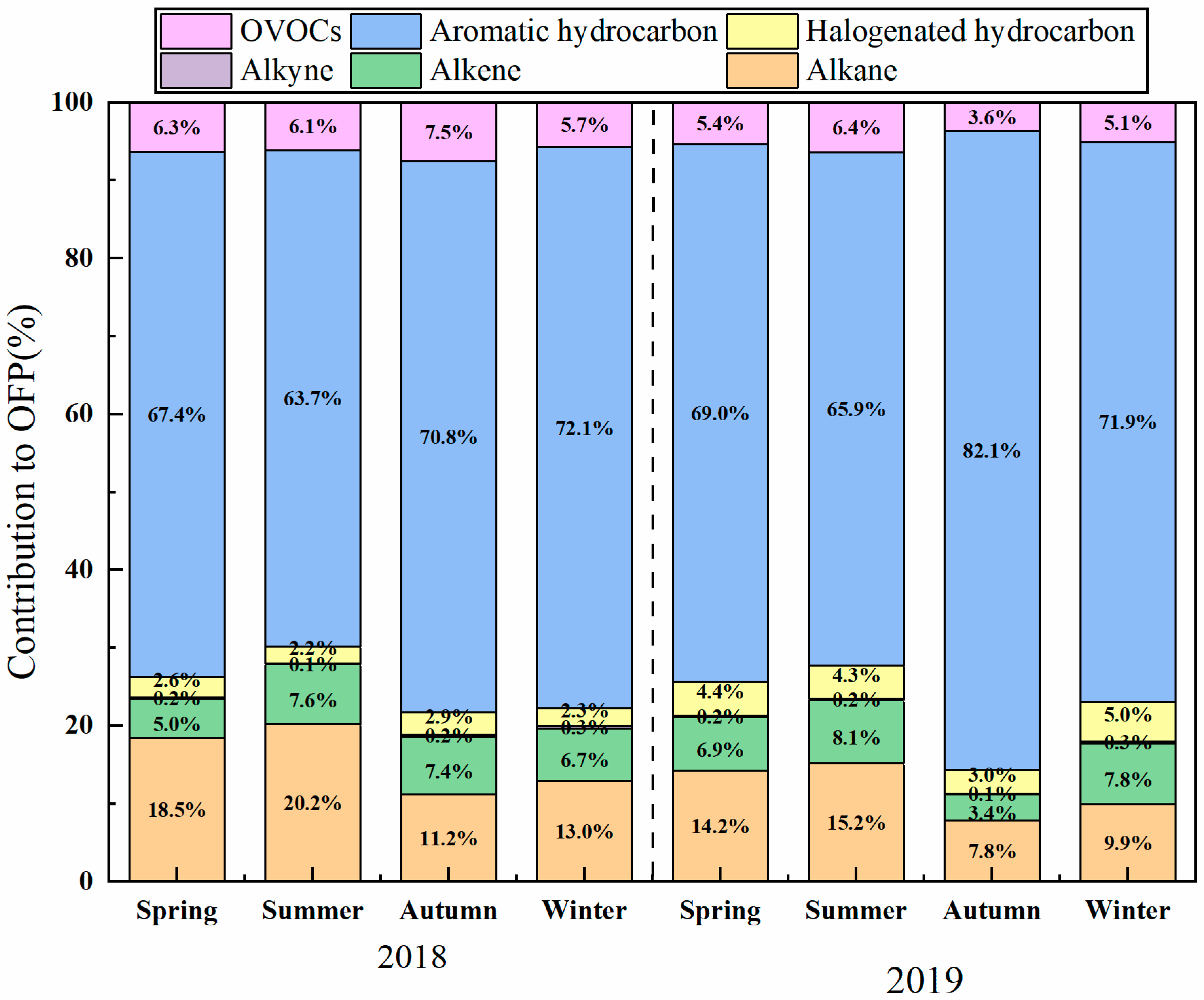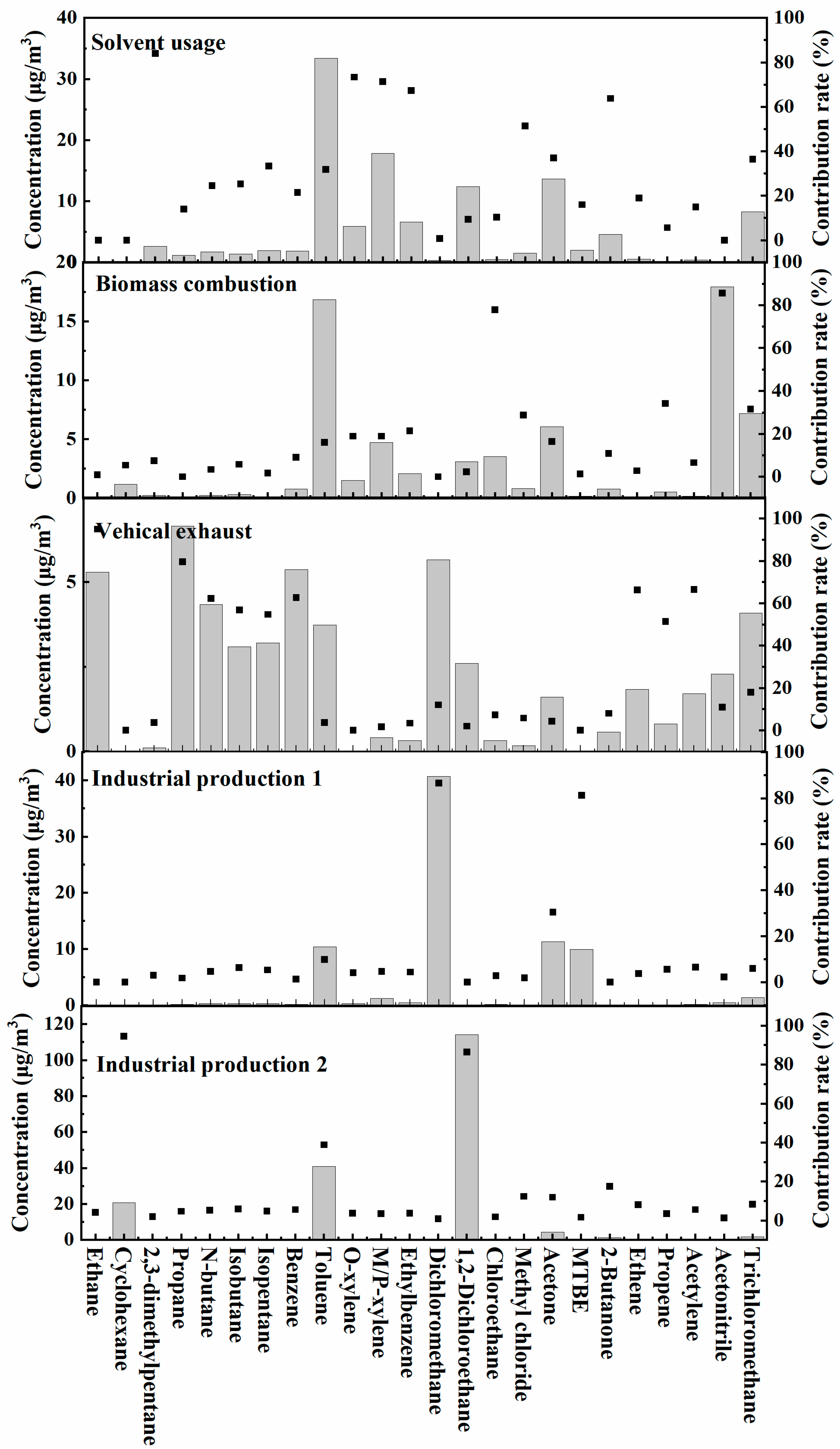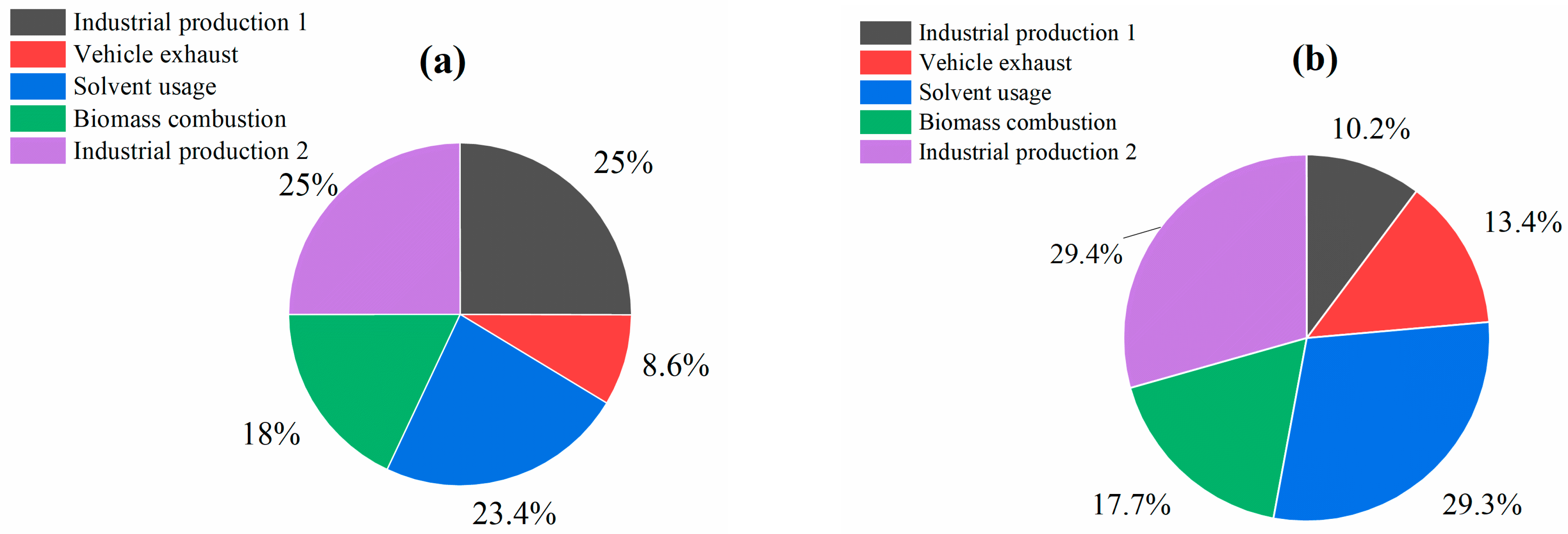The Variation in Emission Characteristics and Sources of Atmospheric VOCs in a Polymer Material Chemical Industrial Park in the Yangtze River Delta Region, China
Abstract
1. Introduction
2. Materials and Methods
2.1. VOCs Sample Collection
2.2. VOCs Sample Analysis
2.3. OFP Calculation Method
2.4. VOCs Source Apportionment Method
3. Results and Discussion
3.1. VOCs Concentration Characteristics
3.1.1. VOCs Concentration Level and Annual Variation
3.1.2. VOCs Component Change Characteristics
3.1.3. OFP Characteristics
3.2. VOCs Source Apportionment
3.2.1. Characteristic Species Ratios
3.2.2. PMF Source Apportionment
4. Conclusions
Author Contributions
Funding
Institutional Review Board Statement
Informed Consent Statement
Data Availability Statement
Conflicts of Interest
References
- Liu, D.; Xie, Q.; Zhang, X.; Wang, H.L.; Yan, Z.Y.; Yang, H.W.; Hao, Z.P. Source apportionment and health risk assessment of VOCs during the haze period in the winter in Beijing. Environ. Sci. 2016, 37, 3693–3701. (In Chinese) [Google Scholar]
- Bari, M.A.; Kindzierski, W.B. Ambient volatile organic compounds (VOCs) in Calgary, Alberta: Sources and screening health risk assessment. Sci. Total Environ. 2018, 631–632, 627–640. [Google Scholar] [CrossRef] [PubMed]
- Tang, X.Y.; Zhang, Y.H.; Shao, M. Atmospheric Environmental Chemistry, 2nd ed.; Higher Education Press: Beijing, China, 2006; pp. 172–175. (In Chinese) [Google Scholar]
- Hui, L.R.; Liu, X.G.; Tan, Q.W.; Feng, M.; An, J.L.; Qu, Y.; Zhang, Y.H.; Jiang, M.Q. Characteristics, source apportionment and contribution of VOCs to ozone formation in Wuhan, Central China. Atmos. Environ. 2018, 192, 55–71. [Google Scholar] [CrossRef]
- Wu, R.R.; Li, J.; Hao, Y.Q.; Li, Y.Q.; Zeng, L.M.; Xie, S.D. Evolution process and sources of ambient volatile organic compounds during a severe haze event in Beijing, China. Sci. Total Environ. 2016, 560–561, 62–72. [Google Scholar] [CrossRef]
- Shao, P.; An, J.L.; Xin, J.Y.; Wu, F.K.; Wang, J.X.; Ji, D.S.; Wang, Y.S. Source apportionment of VOCs and the contribution to photochemical ozone formation during summer in the typocal industrial area in the Yangtze River Delta, China. Atmos. Res. 2016, 176–177, 64–74. [Google Scholar] [CrossRef]
- Kansal, A. Sources and reactivity of NMHCs and VOCs in the atmosphere: A review. J. Hazard. Mater. 2009, 166, 17–26. [Google Scholar] [CrossRef]
- Zheng, J.Y.; Zheng, Z.Y.; Yu, Y.F.; Zhong, L.J. Temporal, spatial characteristics and uncertainty of biogenic VOC emissions in the Pearl River Delta region, China. Atmos. Environ. 2010, 44, 1960–1969. [Google Scholar] [CrossRef]
- Wang, L.J.; Qin, M. Analysis of VOCs characteristics and ozone formation potential in an industrial park in Hubei Province. Ind. Saf. Environ. Prot. 2024, 50, 92–97. (In Chinese) [Google Scholar]
- The State Council. Notice on Issuing the Three Years Action Plan for Winning the Blue Sky Defense War. Available online: https://www.gov.cn/gongbao/content/2018/content_5306820.htm (accessed on 26 May 2025). (In Chinese)
- Ministry of Ecology and Environment of China. Notice on Issuing the Comprehensive Management Plan for Volatile Organic Compounds in Key Industries. Available online: https://www.gov.cn/gongbao/content/2019/content_5442284.htm (accessed on 26 May 2025). (In Chinese)
- Hsu, C.; Chiang, H.; Shie, R.; Ku, C.; Lin, T.; Chen, M.; Chen, N.; Chen, Y. Ambient VOCs in residential areas near a large-scale petrochemical complex: Spatiotemporal variation, source apportionment and health risk. Environ. Pollut. 2018, 240, 95–104. [Google Scholar] [CrossRef]
- Liang, X.M.; Chen, X.; Zhang, J.; Shi, T.; Sun, X.; Fan, L.; Wang, L.; Ye, D. Reactivity-based industrial volatile organic compounds emission inventory and its compounds emission inventory and its implication for ozone control strategies in China. Atmos. Environ. 2017, 162, 115–126. [Google Scholar] [CrossRef]
- Sopian, N.; Jalaludin, J.; Tamrin, S. Risk of respiratory health impairment among susceptible pollution living near petrochemical industry-a review article. Iran. J. Public Health 2016, 45, 9–16. [Google Scholar]
- Cheng, N.N. Research on Ozone Emission Characteristics, Ozone Influencing Mechanism and Pollution Source Tracing in Typical Chemical Industrial Park. Ph.D. Thesis, Zhejiang University, Hangzhou, China, 2022. (In Chinese). [Google Scholar]
- He, M.L.; Xiao, H.L.; Chen, X.F.; Liang, X.M.; Fan, L.Y.; Ye, D.Q. Emission characteristics of volatile organic compounds in chemical industry park based on emission links. China Environ. Sci. 2017, 37, 38–48. (In Chinese) [Google Scholar]
- China Petroleum and Chemical Industry Federation. The Yangtze River Delta Chemical Industrial Park Welcomes New Opportunities. Available online: http://www.ccin.com.cn/detail/60c7712f0af68a4591022ce66bfce270 (accessed on 14 April 2025). (In Chinese).
- China Petroleum and Chemical Industry Federation. Top 30/Top 10 Potential Chemical Industrial Parks Announced in 2021. Available online: https://www.jiemian.com/article/6185111.html (accessed on 14 April 2025). (In Chinese).
- Huang, C.; Chen, C.H.; Li, L.; Cheng, Z.; Wang, H.L.; Streets, D.G.; Wang, J.Y.; Zhang, G.F.; Chen, Y.R. Emission inventory of anthropogenic air pollutants and VOC species in the Yangtze River Delta region, China. Atmos. Chem. Phys. 2011, 11, 4105–4120. [Google Scholar] [CrossRef]
- Wang, K.X.; Zhang, X.; Ji, Y.Y.; Li, H.; Fan, K.; Gao, R.; He, M. Characterization of ambient VOCs in a coal chemical industry park and their contribution to complex air pollution. Res. Environ. Sci. 2023, 36, 294–304. (In Chinese) [Google Scholar]
- Feng, D.D.; Wu, C.Z.; Chen, B.X.; Wang, Q.L.; Zhang, S.H.; Cheng, J.M.; Li, W. Characteristics and source analysis of VOCs in a fine chemical industrial park. J. Chem. Eng. Chin. Univ. 2021, 35, 935–942. (In Chinese) [Google Scholar]
- Dumanoglu, Y.; Kara, M.; Altiok, H.; Odabasi, M.; Elbir, T.; Bayram, A. Spatial and seasonal variation and source apportionment of volatile organic compounds (VOCs) in a heavily industrialized region. Atmos. Environ. 2014, 98, 168–178. [Google Scholar] [CrossRef]
- Buzcu-Guven, B.; Fraser, M.P. Comparison of VOC emissions inventory data with source apportionment results for Houston, TX. Atmos. Environ. 2008, 42, 5032–5043. [Google Scholar] [CrossRef]
- Wang, H.L.; Gao, Y.Q.; Jing, S.X.; Lou, S.R.; Hu, Q.Y.; An, J.Y.; Wu, Y.H.; Gao, W.; Zhu, L.; Huang, C. Characterization of volatile organic compounds (VOCs) using mobile monitoring around the industrial parks in the Yangzte River Delta Region of China. Environ. Sci. 2021, 42, 1298–1305. (In Chinese) [Google Scholar]
- Li, Y.H.; Lin, J.W.; Sun, J.C.; Song, W.Q.; Niu, X.W.; Li, Y.Z. Analysis of atmospheric VOCs pollution characteristics in a chemical industrial in Shenyang. Environ. Pollut. Control 2022, 44, 1175–1181. (In Chinese) [Google Scholar]
- HJ759-2015; Ambient Air-Determination of Volatile Organic Compounds—Collected by Specially—Prepared Canisters and Analyzed by Gas Chromatography/Mass Spectrometry. China Environmental Publisher: Beijing, China, 2015. (In Chinese)
- Deng, Y.Y.; Li, J.; Li, Y.Q. Characteristics of volatile organic compounds, NO2, and effects on ozone formation at a site with high ozone level in Chengdu. J. Environ. Sci. 2019, 01, 334–345. [Google Scholar] [CrossRef]
- Carter, W.P.L.; Heo, G. Development of revised SAPRC aromatics mechanisms. Atmos. Environ. 2013, 77, 404–414. [Google Scholar] [CrossRef]
- Shao, M.; Yuan, B.; Wang, M.; Zheng, J.Y.; Liu, Y.; Lu, S.H. Volatile Organic Compounds in the Atmosphere: Source and The Roles in Atmospheric Chemistry; Science Press: Beijing, China, 2020; pp. 226–228. (In Chinese) [Google Scholar]
- Zhang, H.Y.; Sui, H.X.; Wang, Z.F.; Zhang, S.F.; Du, M.Y.; Ge, X.; Wang, M.; Tao, W.X.; Xu, H.Y.; Gu, D.S.; et al. Characteristics and sources of volatile organic compounds in urban Jinan, China. China Environ. Sci. 2024, 9, 4765–4777. (In Chinese) [Google Scholar]
- Qin, T. Pollution Characteristics, Environmental Effect and Health Risk Assessment of Ambient VOCs in Zibo City. Master’s Thesis, Tianjin University of Technology, Tianjin, China, 2022. (In Chinese). [Google Scholar]
- Sun, Z.; Liu, S.T.; Zhang, H.; Wei, Y.B.; Wang, S.B.; Hong, X.Y.; Wang, X.Q.; Qian, L.M.; Zhu, S. Component characteristics and source analysis of VOCs in autumn in Hefei industrial park. J. Atmos. Environ. Opt. 2024, 19, 185–198. (In Chinese) [Google Scholar]
- Wang, J.; Yao, Z.; Wang, M.Y.; Chen, S.M.; Long, T.; Wang, H.L.; Li, H.; Guo, X.R.; Hao, J.H.; Nie, L. VOCs pollution characteristics and health risk assessment in typical industrial parks in Beijing: Environmental impact of high and new technology industries. Environ. Sci. 2024, 45, 2019–2027. (In Chinese) [Google Scholar]
- Gan, H. Characteristics, Sources and Health Risk Assessment of Atmospheric VOCs in a Chemical Industrial Park of Zibo. Master’s Thesis, Tianjin University of Technology, Tianjin, China, 2022. (In Chinese). [Google Scholar]
- Department of Commerce of Zhejiang Province. Introduction to Shangyu Economic Development Zone in Hangzhou Bay. Available online: http://www.zcom.gov.cn/art/2021/5/24/art_1389612_58930782.html (accessed on 14 April 2025). (In Chinese)
- Ministry of Ecology and Environment of China. Action Plan for Comprehensive Air Pollution Control in the Yangtze River Delta Region in Autumn and Winter in 2018–2019. Available online: https://www.mee.gov.cn/xxgk2018/xxgk/xxgk03/201811/W020181112374953651473.pdf (accessed on 14 April 2025). (In Chinese)
- Ministry of Ecology and Environment of China. Action Plan for Comprehensive Control of Air Pollution in Autumn and Winter in 2019–2020 in the Yangtze River Delta Region. Available online: https://www.gov.cn/zhengce/zhengceku/2019-11/26/content_5455687.htm (accessed on 14 April 2025). (In Chinese)
- Shaoxing Ecological Environment Bureau. The Regulation for the Remediation of Volatile Organic Compound Pollution in the Fine Chemical Industry in Shaoxing City. Available online: https://www.sx.gov.cn/art/2016/5/26/art_1229559239_1839264.html (accessed on 14 April 2025). (In Chinese)
- Shaoxing Ecological Environment Bureau Shangyu Branch. Implementation Plan for Scientific Treatment of Waste Gas in Hangzhou Bay Shangyu Economic and Technological Development Zone in 2024. Available online: https://www.shangyu.gov.cn/art/2024/5/10/art_1229218515_1900943.html (accessed on 14 April 2025). (In Chinese)
- Zhao, F. Variation Characteristics and Sources of Atmospheric Halocarbons in Mount Tai. Master’s Thesis, Shandong University, Jinan, China, 2022. (In Chinese). [Google Scholar]
- Yuan, Y. Research on innovation and development of polymer materials processing technology. Henan Sci. Technol. 2022, 25, 39–41. (In Chinese) [Google Scholar]
- Zhang, D.; He, B.; Yuan, M.; Yu, S.; Yin, S.; Zhang, R. Characteristics, sources and health risks assessment of VOCs in Zhengzhou, China during haze pollution season. J. Environ. Sci. 2021, 108, 44–57. [Google Scholar] [CrossRef]
- Li, J.Y.; Xie, X.D.; Li, L.; Wang, X.Y.; Wang, H.L.; Jing, S.A.; Ying, Q.; Qin, M.M.; Hu, J.L. Fate of oxygenated volatile organic compounds in the Yangtze River Delta Region: Source contributions and impacts on the atmospheric oxidation capacity. Environ. Sci. Technol. 2022, 56, 11212–11224. [Google Scholar] [CrossRef]
- Wang, Z.Y.; Tian, X.; Li, J.; Wang, F.; Liang, W.; Zhao, H.; Huang, B.; Wang, Z.H.; Feng, Y.C.; Shi, G. Quantitative evidence from VOCs source apportionment reveals O3 control strategies in northern and southern China. Environ. Sci. 2023, 172, 107786. [Google Scholar] [CrossRef]
- Zou, Y.; Yan, X.L.; Flores, R.M.; Zhang, L.Y.; Yang, S.P.; Fan, L.Y.; Deng, T.; Ye, D.Q. Source apportionment and ozone formation mechanism of VOCs considering photochemical loss in Guangzhou, China. Sci. Total Environ. 2023, 903, 166191. [Google Scholar] [CrossRef]
- Yang, D.Y. Research on the Sources of VOCs and Ozone Generation Potential Under Clean Heating in Rural Areas of North China. Master’s Thesis, North China Electric Power University, Beijing, China, 2023. (In Chinese). [Google Scholar]
- Qiao, S.Y.; Guan, J.W.; Guan, L.; Zhang, T.; Wang, Y.Y.; Shen, J.D.; Yu, X.N. Composition characteristics of volatile organic compounds and contribution to secondary pollution formation in Hangzhou. China Environ. Sci. 2024, 44, 1921–1928. (In Chinese) [Google Scholar]
- Pang, X.D.; Gao, B.; Chen, L.G.; Liu, M.; Lu, H.T.; Wang, S.; Zhao, W.; Liang, X.M.; Guo, S.J. Characteristics and source apportionment of volatile organic compounds in Zhanjiang in Summer. Environ. Sci. 2023, 44, 2461–2471. (In Chinese) [Google Scholar]
- Zhang, P.H.; Hu, D.M.; Peng, L.; Niu, W.L.; Gong, X.X.; Yan, Y.L.; Niu, Y.Y.; Dong, J.Q. Characteristics and sources of atmospheric VOCs pollution in Jincheng. China Environ. Sci. 2023, 9, 4525–4533. (In Chinese) [Google Scholar]
- Fu, Y.M. Analysis of Pollution Characteristics and Sources of VOCs in Ezhou City Based on PMF. Master’s Thesis, Wuhan University of Technology, Wuhan, China, 2020. (In Chinese). [Google Scholar]
- Guenther, A.; Geron, C.; Pierce, T.; Lamb, B.; Harley, P.; Fall, R. Natural emissions of nonmethane volatile organic compounds, carbon monoxide, and oxides of nitrogen from North America. Atmos. Environ. 2000, 34, 2205–2230. [Google Scholar] [CrossRef]
- Yuan, B.; Shao, M.; de Gouw, J.; Parrish, D.D.; Lu, S.H.; Wang, M.; Zeng, L.M.; Zhang, Q.; Song, Y.; Zhang, J.B.; et al. Volatile organic compounds (VOCs) in urban air: How chemistry affects the interpretation of positive matrix factorization (PMF) analysis. J. Geophys. Res. Atmos. 2012, 117, 1–17. [Google Scholar] [CrossRef]
- Shi, X.X.; Zheng, G.D.; Shao, Z.Z.; Gao, D. Effect of source-classified and mixed collection from residential household waste bins on the emission characteristics of volatile organic compounds. Sci. Total Environ. 2020, 707, 135478. [Google Scholar] [CrossRef]
- Niu, Z.Z.; Kong, S.F.; Yan, Q.; Zheng, S.R.; Zheng, H.; Zeng, X.; Yao, L.Q.; Wu, J.; Wu, F.Q.; Cheng, Y.; et al. Profile characteristics of VOCs from wood and economic crop burning. Environ. Sci. 2020, 41, 1107–1115. (In Chinese) [Google Scholar]
- Wang, C.H.; Chen, J.H.; Han, L.; Xu, C.X.; Wang, B.; Li, Y.J.; Liu, Z.; Qian, J. Seasonal pollution characteristics and analysis of the sources of atmospheric VOCs in Chengdu urban area. Environ. Sci. 2020, 41, 3951–3960. (In Chinese) [Google Scholar]
- Zhang, B.T.; Jing, K.; Wang, Q.; An, X.X.; Lu, H.F.; Wang, C.J.; Wang, Y.F.; Liu, B.X. Characteristics and source apportionment of VOCs initial Mixing Ratio in Beijing during summer. Environ. Sci. 2024, 24, 81–92. (In Chinese) [Google Scholar]
- Jiang, Z.M.; Yang, M.Y.; Wang, Y.; Zhang, Y.J.; Peng, H.H.; Lin, X.H.; Gao, Y.H. Characteristics and source apportionment of atmospheric volatile organic compounds in Zhongshan. Environ. Pollut. Control 2023, 45, 843–854. (In Chinese) [Google Scholar]
- Meng, X.L.; Sun, Y.; Liao, T.T.; Zhang, C.; Zhang, C.Y. Characteristic analysis and source apportionment of VOCs in urban areas of Beijing in summer. Environ. Sci. 2022, 22, 4484–4496. (In Chinese) [Google Scholar]
- Niu, Y.Y.; Liu, Z.C.; Li, R.M.; Gao, Q.Z.; Deng, M.J.; Yan, Y.L.; Hu, D.M.; Wu, J.; Peng, L. Characteristics, source apportionment, and environmental impact of volatile organic compounds in summer in Yangquan. Environ. Sci. 2020, 7, 3066–3075. (In Chinese) [Google Scholar]








| Location | Year | TVOCs | Alkane | Alkene | Alkyne | Halogenated Hydrocarbon | Aromatic Hydrocarbon | OVOCs |
|---|---|---|---|---|---|---|---|---|
| SYIP | 2018 | 369.7 | 79.4 | 9.7 | 4.1 | 139.8 | 65.4 | 49.2 |
| SYIP | 2019 | 286.1 | 57.2 | 7.3 | 3.3 | 103.0 | 65.8 | 32.3 |
| A tire manufacturing industrial park in Anhui Province [32] | 2021 | 40.6 | 13.9 | 6.4 | — | 6.6 | 3.1 | 10.7 |
| An electronics product manufacturing industrial park in Beijing City [33] | 2023 | 72.7 | 27.0 | 7.3 | 2.3 | 13.4 | 7.3 | 15.3 |
| A chemical industrial park in Hubei Province [9] | 2021 | 55.3 | 17.0 | 5.1 | 4.5 | 18.3 | 3.5 | 6.7 |
| A chemical industrial park in Shandong Province [34] | 2021 | 189.1 | 99.0 | 42.4 | - | 10.0 | 12.8 | 23.6 |
| A fine chemical industrial park in Zhejiang Province [21] | 2018 | 381.9 | 82.9 | 7.6 | 3.5 | 146.1 | 67.9 | 74.5 |
| A coal chemical industrial park in Shanxi Province [20] | 2021 | 89.3 | 19.1 | 7.3 | 1.5 | 13.9 | 4.2 | 43.1 |
| Year | Order | Spring | Summer | Autumn | Winter | ||||
|---|---|---|---|---|---|---|---|---|---|
| Species | ppb | Species | ppb | Species | ppb | Species | ppb | ||
| 2018 | 1 | 1,2-Dichloroethane | 72.2 | Dichloromethane | 99.3 | Dichloromethane | 48.4 | Dichloromethane | 37.7 |
| 2 | Toluene | 62.0 | Acetone | 54.6 | Toluene | 34.2 | Toluene | 26.9 | |
| 3 | Dichloromethane | 57.6 | Toluene | 52.5 | Acetonitrile | 28.3 | Acetone | 20.0 | |
| 4 | Acetone | 52.3 | Acetonitrile | 44.8 | 1,2-dichloroethane | 28.0 | 1,2-dichloroethane | 15.8 | |
| 5 | 2-Methylpentane | 28.4 | 2-Methylpentane | 42.6 | Acetone | 26.2 | Freon 11 | 7.1 | |
| 6 | Cyclohexane | 22.2 | 1,2-Dichloroethane | 40.9 | 2-Methylpentane | 9.0 | Ethane | 7.1 | |
| 7 | Acetonitrile | 16.1 | Cyclohexane | 16.5 | Ethyl chloride | 8.3 | Ethyl chloride | 6.1 | |
| 8 | 2,3-Dimethylpentane | 11.9 | 2,3-Dimethylpentane | 10.3 | m/p-Xylene | 8.1 | Propane | 6.0 | |
| 9 | Ethyl chloride | 10.1 | Freon 11 | 7.1 | Freon 113 | 7.8 | Acetonitrile | 5.1 | |
| 10 | Freon 11 | 8.0 | m/p-Xylene | 6.8 | Chloroform | 6.7 | m/p-Xylene | 4.8 | |
| 2019 | 1 | 1,2-Dichloroethane | 58.1 | 1,2-Dichloroethane | 46.3 | Toluene | 61.6 | Toluene | 25.0 |
| 2 | Toluene | 32.5 | Toluene | 36.3 | Freon 11 | 27.2 | 1,2-Dichloroethane | 21.6 | |
| 3 | Acetone | 18.7 | Acetone | 28.9 | 1,2-Dichloroethane | 27.0 | Acetonitrile | 17.6 | |
| 4 | Dichloromethane | 15.5 | Dichloromethane | 23.8 | m/p-Xylene | 24.7 | Dichloromethane | 14.6 | |
| 5 | Acetonitrile | 14.8 | Acetonitrile | 18.0 | Acetonitrile | 20.0 | Chloroform | 12.3 | |
| 6 | Cyclohexane | 11.6 | Cyclohexane | 14.89 | Acetone | 19.8 | Acetone | 10.4 | |
| 7 | 2,3-Dimethylpentane | 7.7 | 2,3-Dimethylpentane | 10.2 | Dichloromethane | 9.7 | Ethyl chloride | 7.1 | |
| 8 | Chloroform | 6.4 | Freon 11 | 8.7 | 1,3-Dichlorobenzene | 9.4 | Ethane | 6.7 | |
| 9 | MTBE | 6.1 | MTBE | 7.3 | Ethylbenzene | 8.5 | Propane | 6.6 | |
| 10 | m/p-Xylene | 5.7 | Ethyl chloride | 5.9 | Ethyl chloride | 8.1 | m/p-Xylene | 6.6 | |
| Year | Order | Spring | Summer | Autumn | Winter | ||||
|---|---|---|---|---|---|---|---|---|---|
| Species | μg/m3 | Species | μg/m3 | Species | μg/m3 | Species | μg/m3 | ||
| 2018 | 1 | Toluene | 1359.1 | Toluene | 1149.4 | Toluene | 748.5 | Toluene | 588.5 |
| 2 | m/p-Xylene | 269.7 | m/p-Xylene | 283.5 | m/p-Xylene | 341.1 | m/p-Xylene | 202.7 | |
| 3 | 2-Methylpentane | 168.4 | 2-Methylpentane | 252.0 | Ethylbenzene | 138.3 | Ethylbenzene | 137.2 | |
| 4 | Cyclohexane | 129.3 | Cyclohexane | 96.1 | o-Xylene | 131.4 | o-Xylene | 66.5 | |
| 5 | Ethylbenzene | 121.1 | Ethylbenzene | 89.7 | 1,3,5-Trimethylbenzene | 70.7 | Ethylene | 39.9 | |
| 6 | o-Xylene | 82.0 | o-Xylene | 85.6 | 1,2,4-Trimethylbenzene | 56.8 | 1,2,4-Trimethylbenzene | 34.4 | |
| 7 | 2,3-Dimethylpentane | 73.2 | 2,3-Dimethylpentane | 63.2 | 2-Methylpentane | 51.8 | 2-Methylpentane | 24.8 | |
| 8 | Acetone | 48.8 | Acetone | 50.9 | 1,3-Butadiene | 43.9 | Cyclohexane | 24.3 | |
| 9 | Hexanal | 44.8 | Isoprene | 41.3 | Hexanal | 36.9 | Propylene | 21.1 | |
| 10 | 1,2,4-Trimethylbenzene | 42.6 | 1,2,4-Trimethylbenzene | 37.5 | Pentanal | 36.1 | 1,2,3-Trimethylbenzene | 20.0 | |
| 2019 | 1 | Toluene | 712.4 | Toluene | 794.7 | Toluene | 1350.3 | Toluene | 547.6 |
| 2 | m/p-Xylene | 239.3 | m/p-Xylene | 233.0 | m/p-Xylene | 1033.8 | m/p-Xylene | 277.5 | |
| 3 | Ethylbenzene | 100.9 | Ethylbenzene | 86.5 | o-Xylene | 334.3 | o-Xylene | 87.4 | |
| 4 | o-Xylene | 76.8 | Cyclohexane | 86.3 | Ethylbenzene | 308.3 | Ethylbenzene | 82.5 | |
| 5 | Cyclohexane | 67.5 | o-Xylene | 77.8 | 1,2,4-Trimethylbenzene | 84.6 | Trichlorethylene | 45.0 | |
| 6 | 2,3-Dimethylpentane | 47.7 | 2,3-Dimethylpentane | 62.7 | 1,2,3-Trimethylbenzene | 58.2 | Ethylene | 35.5 | |
| 7 | Trichlorethylene | 43.3 | Trans-2-butene | 42.8 | 1,3,5-Trimethylbenzene | 57.1 | Propylene | 25.2 | |
| 8 | 1,2,4-Trimethylbenzene | 32.7 | Trichlorethylene | 32.5 | 3-Ethyltoluene | 47.9 | 1,2,4-Trimethylbenzene | 23.8 | |
| 9 | Ethylene | 28.7 | 1,2,4-Trimethylbenzene | 30.7 | 1,4-Diethylbenzene | 47.5 | Benzene | 19.4 | |
| 10 | Trans-2-butene | 28.2 | Ethyl Chloride | 30.0 | Trichlorethylene | 45.9 | 1,3,5-Trimethylbenzene | 13.9 | |
Disclaimer/Publisher’s Note: The statements, opinions and data contained in all publications are solely those of the individual author(s) and contributor(s) and not of MDPI and/or the editor(s). MDPI and/or the editor(s) disclaim responsibility for any injury to people or property resulting from any ideas, methods, instructions or products referred to in the content. |
© 2025 by the authors. Licensee MDPI, Basel, Switzerland. This article is an open access article distributed under the terms and conditions of the Creative Commons Attribution (CC BY) license (https://creativecommons.org/licenses/by/4.0/).
Share and Cite
Li, W.; Wu, J.; Xu, C.; Wang, R. The Variation in Emission Characteristics and Sources of Atmospheric VOCs in a Polymer Material Chemical Industrial Park in the Yangtze River Delta Region, China. Atmosphere 2025, 16, 687. https://doi.org/10.3390/atmos16060687
Li W, Wu J, Xu C, Wang R. The Variation in Emission Characteristics and Sources of Atmospheric VOCs in a Polymer Material Chemical Industrial Park in the Yangtze River Delta Region, China. Atmosphere. 2025; 16(6):687. https://doi.org/10.3390/atmos16060687
Chicago/Turabian StyleLi, Wenjuan, Jian Wu, Chengcheng Xu, and Rupei Wang. 2025. "The Variation in Emission Characteristics and Sources of Atmospheric VOCs in a Polymer Material Chemical Industrial Park in the Yangtze River Delta Region, China" Atmosphere 16, no. 6: 687. https://doi.org/10.3390/atmos16060687
APA StyleLi, W., Wu, J., Xu, C., & Wang, R. (2025). The Variation in Emission Characteristics and Sources of Atmospheric VOCs in a Polymer Material Chemical Industrial Park in the Yangtze River Delta Region, China. Atmosphere, 16(6), 687. https://doi.org/10.3390/atmos16060687





